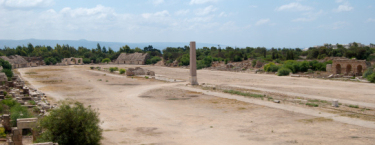The Macedonian king Alexander the Great connected Tyre to the mainland when he built a connecting road (stretching almost .6 miles or one kilometer) as a means of attacking the city's formidable defenses.
Tyre (also referred to as Tyrus) is mentioned at least 59 times in the King James Version Bible. The city is prophesied against by the prophets Isaiah (chapter 23), Ezekiel (chapter 26), Jeremiah (chapter 25), Joel (chapter 3), Amos (first chapter) and Zechariah (chapter 9). The first Biblical reference to Tyre is as one of the "strong" cities the Israelite tribe of Asher was to inherit in the Promised Land.
And the fifth lot came out for the tribe of the children of Asher according to their families . . . And the border turns to Ramah, and to the strong city Tyre. And the border turns to Hosah, and the boundaries of it are at the sea from the line to Achzib . . . (Joshua 19:24, 29, HBFV throughout).

A Short Visit
The Apostle Paul landed in Tyre toward the end of his third missionary journey. It was after sailing from Patara in Asia Minor (Acts 21:1 - 3). A well-known Biblical commentary on his life states the following regarding the journey.
"The distance between these two points (Patara and Tyre) is three hundred and forty geographical miles; and if we bear in mind that the north-westerly winds in April often blow like monsoons in the Levant . . .
"and that the rig of ancient sailing vessels was peculiarly favorable to a quick run before the wind, we come at once to the conclusion that the voyage might easily be accomplished in forty-eight hours" (Life and Epistles of Paul by Conybeare and Howson, Chapter 20, section on Patara).
Paul met with local disciples in Tyre for one week while the ship he was on was unloading in the city's port.
"When Apostle Paul came to this city (Tyre), it was neither in the glorious state described in the prophecies of Ezekiel and Isaiah, (Ezekiel 26 - 27, Isaiah 23) when "its merchants were princes, and its traffickers the honorable of the earth," nor in the abject desolation in which it now fulfils those prophecies, being "a place to spread nets upon," and showing only the traces of its maritime supremacy in its ruined mole . . .
"In honor of its ancient greatness, the Romans gave it the name of a free city (a city which, though under Rome, was permitted to have their own laws plus other privileges like making their own coins); and it still commanded some commerce, for its manufactures of glass and purple were not yet decayed . . ." (ibid., section on Tyre).
Some of the brethren in Tyre, inspired by God, warned him to stay away of the dangers that awaited him in Jerusalem (Acts 21:4). The apostle would not be deterred, however, in his goal of reaching the city in time to keep the Day of Pentecost (20:16).
After a group of Tyre brethren, including women and children, prayed with him on the shore, Paul got back on his ship and left for the port city of Ptolemais (Acts 21:5 - 7).